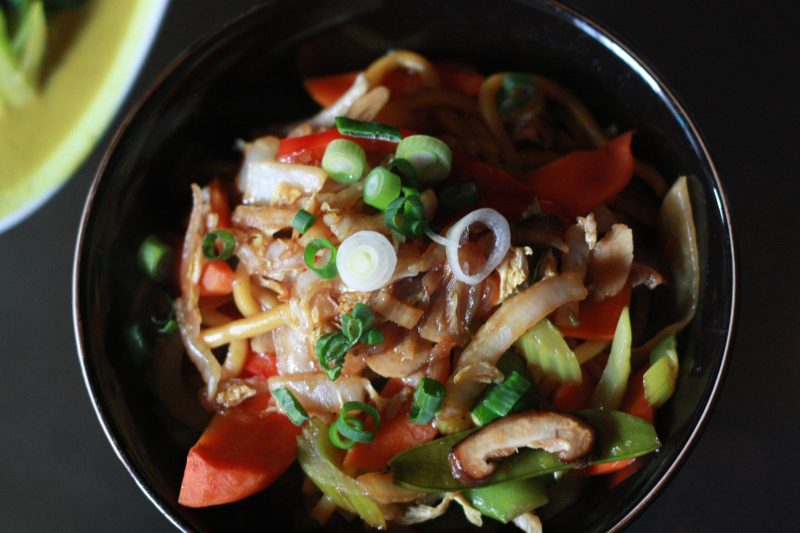One of the simplest, yet most confounding aspect of a Chinese menu is the different sections for lo mein and chow mein noodles. They share the same name and are both noodles – how different can they be? Like two siblings with the same parents, they can be miles apart. This is the definitive guide to help you understand what those differences are between the noodles.
Origin

“Mein” means “noodle”; “chow” means “stir-fried”; “lo” means “tossed”. Knowing the etymology of these words already helps decipher their differences. China is such a vast country in land area that it encompasses 5 time zones and different agricultural capabilities. Wheat is the second-most abundant grain crop, behind rice, and is grown in the North China Plain. Both chow mein and lo mein hail from this region and are made from wheat flour tossed with eggs.
Texture

- Lo mein tends to be soft noodles that can either be round or flat.
- Chow mein, because it is stir-fried, can vary in texture depending on how much oil is used in the wok and how long you stir-fry them. They can be crispy or slightly firm.
To illustrate their differences in texture, if you are cooking at home and don’t have either egg noodles handy, fettucini can be substituted for lo mein while ramen noodles can be subbed from chow mein.
Preparation

How the noodles are prepared are really where their differences become distinguishable. Both need to be parboiled but that’s where their commonalities end.
Chow Mein Noodles Preparation
- Chow mein noodles are usually dried so you should parboil them for 5-6 minutes.
- Chow mein noodles are parboiled then added to the wok with the meat and vegetables to stir-fry all of the ingredients together.
- If you want crunchier noodles, you can stir-fry them separately so they don’t absorb any of the meat or vegetable liquids make them softer.
Lo Mein Preparation
- Lo mein noodles are usually fresh so need only to be parboiled for 2-3 minutes.
- Lo mein is parboiled then the meat, vegetables, and sauce are added on top, tossed, and ready to eat.
- Lo mein doesn’t have the extra step of stir-frying the noodles like chow mein.
Flavors

Another big difference between them is that lo mein dishes often have thick, aromatic, and flavorful sauces accompanying them. The sauce in a lo main dish is a show stopper. Chow mein, conversely, usually just requires a little bit of soy sauce. The spices added to the meat and vegetables are the main source of flavors.
Nutrition
Although both noodles have the relative same nutritional value because they are both wheat noodles, there are slight differences. For every cup of noodles, lo mein contains 180 calories and chow mein contains 250 calories when they are dry. The big spike in differences appears in the preparation. They can both dramatically increase in calories considering the sauces used, meats, portions, and, in the case of chow mein, how much oil is used to stir-fry it.
Lo Mein Recipes
Easy Lo Mein

This simple vegetarian recipe is classic as it contains components that are found in traditional Asian dishes: mushrooms, carrots, peppers, peas and spinach. By making your own sauce, you get to control the heat, sweetness, and sodium.
Chicken Lo Mein

Combing poultry with veggies and noodles give you a well balanced meal. The ingredients come today in a take-out style dish which will wow your whole family. The easy preparations and executions make it a great option for weekday dinners.
20-Minute Beef and Broccoli Lo Mein

This quick but flavorful dish has a few more ingredients in the sauce. The first time you make it, allot yourself enough time to familiarize yourself with them. Once you make it once, however, you’ll realize how simple it actually is. You can adjust the flavors to your liking. The crunchiness of the brightly colored broccoli makes is nutritious, delicious, and visually pleasing.
Chow Mein Recipes
Vegetarian Chow Mein

This vegetarian meal uses tofu as a protein source. If you’ve never had tofu or baked it, now is the time to try. It is utilized in many Asian dishes and, the more familiar you come with it, the more you can expand your culinary skills. Because the tofu is marinaded, it adds a powerful dimension to this dish.
Chicken Chow Mein

This recipe really turns up the heat, literally. Using your wok with a high flame will make you feel like you’re preparing genuine take out. And it’s just as delicious. Slicing the chicken crosswise will also make it dish appear to be straight out of a pagoda shaped container. Transferring the meats and vegetables to cook separately then adding the noodles together is a culinary circus that ends in applause.
Beef Chow Mein

Beef Chow Mein is the quintessential Chinese dish. The North American version uses way too much sauce. This recipe, however, has the right proportions of sauce, heat, meat, and vegetables. It is created in steps that, although seemingly complicated, is just the way chow mein is made and becomes second nature after recreating this recipe one or two times.
So now that you understand the difference between these noodles, you can order with confidence and expand your choices. Better yet, you can skip the telephone call and make these yourself!
